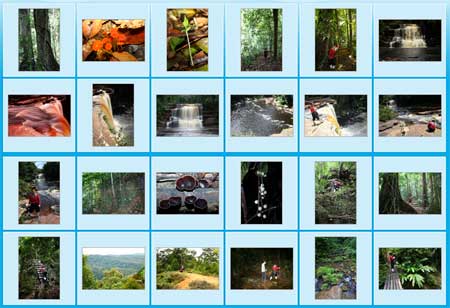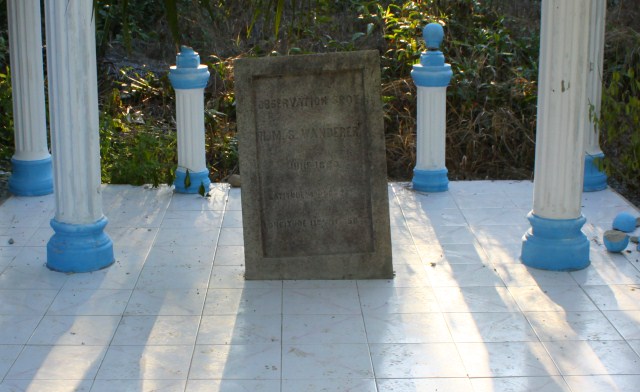Continued from Part 7
You can skip this if you are not interested in visiting Maliau Basin. This is the last blog entry for my Maliau Basin trip. It is more like some post mortem records that might be useful for anyone who plans a trip to Maliau Basin.
Notes for Travellers
- You need to be reasonably fit to go to Maliau Basin. The terrain is rugged and trail is not tourist-friendly. If you are too exhausted, you won’t be able to enjoy the view. You don’t need to be as strong as a hunk. A few months of regular exercise before the trip will help a lot.
- Control your water ration during jungle trekking. Sip a bit for every 500 Meters to 1 KM. If you take big quantity of water at a time and you sweat heavily, your body will ask for more water, drinking too much then you will sweat more and lose more body salt. Later you will find that no matter how much you drink, your body is getting weaker. At last, you run out of water and suffer dehydration. Bring a few packs of rehydration salt (costs only RM0.50 per pack) with you to replenish salt if necessary.

- Reduce the weight that you carry. For example, I had only 2 set of clothing in 6 days. I wear the “dirty set” during daytime trekking, wash it in the evening and leave it to dry over the night, and another “clean set” is for bed time.
- You can save some $ if you don’t ask the travel agent to cook for you. In that case, you must have a good cook in your team, and that person should be an experienced cook who can plan the menu and ration the food quantity accordingly. It’s stressful if everyone is really tired and hungry but doesn’t know how to cook a proper meal.
- The trip will be much more enjoyable if there is a botanist, birdwatcher or naturalist joining you, as they can point out all the unique things in Maliau Basin. It is quite a sad thing to pass by those rare flora & fauna, without knowing that they are worth a closer look. The rangers speak very limited English. I’m afraid they can’t tell you much unless you can speak our local language.

- Start the trekking early in the morning and walk slow. You can walk slowly if you start early. Besides, it is a bit warm in the afternoon. Even the most photogenic place will look less ideal for photography if we get there in the afternoon, due to the harsh afternoon light.
- If you only want a short trip and ask me what are the “must-see” attractions in Maliau Basin, I will say (1) Maliau Falls and (2) Heath Forest (many pitcher plants).

- I will go to Maliau Basin again. Next time I want to visit (1) the 12 hectares Linumunsut freshwater Lake, (2) Takob-Akob Waterfall, and (3) Garden of Eden (currently inaccessible due to land erosion. They say it looks like Japanese garden full of flower).
- There are only 5 ways to get cheaper tour package to Maliau Basin:-
(1) going in big group, you can get nearly 50% discount if your group is big, say, 10 people.
(2) DIY. Try to do everything yourself, e.g., cook your own meal, use own transport, don’t use porter.
(3) Write-in to Yayasan Sabah (Management of Maliau) to waive various fees such as permit, photography and guide. You can try this if you organise trip for education, tourism, government or NGO sector. But no guarantee they will approve.
(4) Malaysians get cheaper price than foreigners. For those foreigners who like to complain about the discriminating pricing, well, many Malaysians study in overseas universities and pay expensive school fees in “international rate” for a few years. I don’t see any problem to charge foreigner tourists for higher price.
(5) The prices offer by different travel agents in different time can vary greatly. You need to shop around for the best deal. But cheap doesn’t mean good. You have to be careful of the hidden cost.

Notes for Photographers
Below are some advices for the photographers. Even compact camera users will find the guide below contains very useful tips:
- You need a permit to photograph in Maliau Basin. Mine was waived so I am not sure how much it costs. But I heard that it is very expensive. Anyway, it may sound unreasonable to stop a tourist to take photo, so I don’t know how strict this is enforced. Do ask if you want to photograph Maliau.

- Tripod is a must, though it adds extra weight to your back. You will really appreciate it for waterfall and landscape shots. Under the forest canopy is also a dark world. My sturdy Manfratto tripod is 2 Kg. At first I bought a mini 1Kg-tripod to replace it. Then I decided to bring the best tripod. My extra effort did pay off.
- If possible, organise the trip with a group of photographers. If you go to Maliau Basin with ordinary travellers, they will not wait for you to setup tripod and spend a long time to shoot an object. Non-photographers are also lack of motivation to wake up and move earlier, so you cannot earn more time for taking photos along the trail.

- Taking photos needs a lot of energy. Exercise as much as possible, to make sure you are physically fit. If you are really fit, you can afford to stop by to photograph, then catching up with the group who always leaves you behind. Do not forget you need to carry heavy camera and tripod.
- Use LCD Screen Protector for the LCD of your camera. It is only RM50 (about USD$15). I am glad I did because it did stop a severe damage to my LCD. In long hours of jungle trekking and climbing in hostile terrain, bad thing can happen to your camera anytime. Just treat this RM50 as an insurance for your fragile camera.
- Bring spare batteries, and a lot of them. Instead of spending a few thousands to buy too many DSLR camera batteries, you can buy a battery grip, which costs RM300 to RM500 (about USD$90 – 160), then buy many AA batteries, which can be used for your camera (and external flash). For this 6-day-5-night trip, I finished all 50 AA batteries. In Maliau Basin (except Maliau Basin Studies Center), the camps have no power point for you to recharge your batteries.

- Get the best AA batteries. I was using Energizer brand AA batteries. I found that its Ultimate Lithium battery (blue & silver color) can last 3 to 4 times longer than its ordinary alkaline battery (black color). Though Ultimate Lithium battery is very expensive (RM8 each) compared to ordinary black Energizer battery (RM2 each), I recommend you to cut down your weight by using more Ultimate Lithium batteries. Though holding more power, surprisingly this Lithium battery is half the weight of ordinary alkaline battery. I was annoyed that 6 ordinary alkaline batteries (for battery grip) could not last even one day.
- Bring more memory cards. Without enough memory card, extra batteries are also useless. It’s better to have spare memory cards, especially if you shoot in RAW format. The less you worry about memory constraint, the more you shoot and the more likely you will get more good photos. Make sure you format the cards before the trip. Instead of buying one big memory card, it is safer to buy a few smaller cards. For example, it is better to buy two 8GB cards than one 16GB card. If your single big memory card damages, you lose all eggs in a basket.

- You can hire a porter to carry your camera bag. But you should keep some spare memory cards and batteries with you. The porters understand very limited English. Even though I instructed them a few times to stay close with me, they “disappear” when I was out of memory card or battery!
- Raincoat is necessary. Raining is very common in Maliau. In case of rain, the raincoat will protect your camera from the rain. And make sure your camera bag comes with a rain cover. If your porter carries your camera bag, show them the rain cover so they know how to keep your camera bag dry in rain.

If you are interested to go to Maliau Basin, you may contact Borneo Nature Tours for more info.
Photos taken in Maliau Basin, Sabah, Malaysia Borneo
All Articles of Maliau Basin Trip:
Part 1. Introduction to Maliau Basin
Part 2. Day 1 in Maliau Basin
Part 3. Day 2 in Maliau. Trekking to the 1st camp
Part 4. Day 3 in Maliau. Maliau Waterfall
Part 5. Day 4 in Maliau. Entering the garden of pitcher plant
Part 6. Day 5 in Maliau. Skybridge & Night Safari
Part 7. Day 6 in Maliau. Leaving Maliau
Part 8. Conclusion & Notes
More Photos
You may check out my Maliau Basin photo album for more pictures:

BONUS! More new photos of Maliau Basin…




I think all the guiding rangers are more interesting in getting their job done as fast as possible. They wouldn’t wait. When I was there, we were like playing hide and seek. And you’re right about buying more memory cards with smaller space than one single memory card with large space. IN a trip like MB, we really don’t want to spoil the whole bucket of eggs. 🙂
the ranger is ok. usually they would not leave the last person behind, only the porters.
in fact, i was looking for a reason to tip the porters. since they are more interested in providing labor service rather than service, i kept the $ in my pocket then.
Please note that there is a fee for bringing your camera into the Maliau Basin Conservation Area. The package you’d paid is inclusive of the photography fee. Having the right contacts and knowing the right guide also help. I am planning for another “Maliau Basin Wilderness Trip” in November 2010 (limited) especially for keen nature photographers…
Borneo Naturalist> thanks for the info. I knew you would find my blog one day. we saw a lot of flora during our trip but didn’t have much chance to look for interesting fauna. may i have more detail of your Nov trip? TQ
very interesting the way you wrote it down. it makes me start to do some saving for this trip. inside my bucket list! 🙂